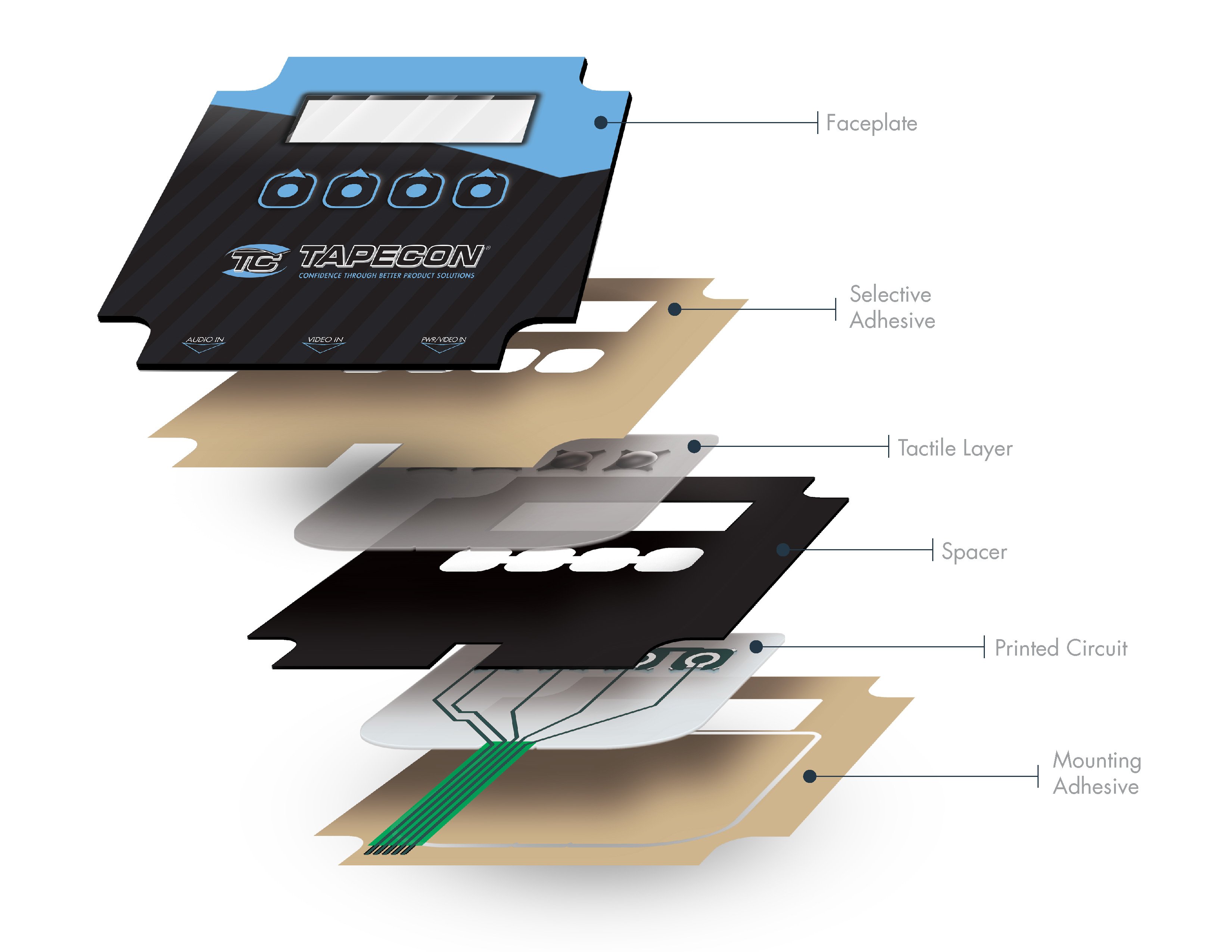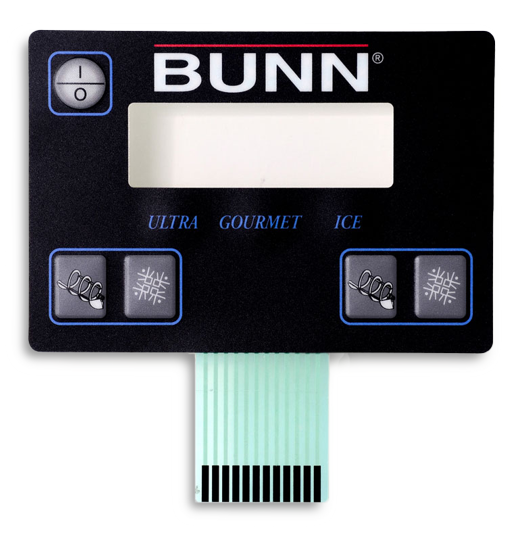Next-Gen Design Options from a Top Membrane Switch Manufacturer
Next-Gen Design Options from a Top Membrane Switch Manufacturer
Blog Article
Comprehending the Value of Membrane Switch in Modern Electronic Devices and Their Applications
Membrane switches over work as an important component in modern electronics, supplying a reliable user interface for user interaction. Their personalized and lightweight nature makes them ideal for an array of applications across varied markets. Understanding their essential elements and advantages can supply insights right into their expanding significance. As innovation continues to development, the evolution of Membrane switches elevates inquiries about their future applications and style technologies. What exists ahead in this dynamic field?

What Are Membrane Switches?
Membrane buttons are crucial elements in modern electronic devices, acting as customer interfaces that help with interaction between users and tools. These switches include several layers, including a visuals overlay, an adhesive layer, and a circuit layer, every one of which interact to produce a long lasting and useful interface. The design permits for a flat, low-profile remedy that can be personalized relating to size, shape, and aesthetic appearance, making them appropriate for numerous applications, from consumer electronic devices to clinical tools. The tactile comments provided by Membrane switches improves individual experience, while their resistance to dirt and wetness makes them ideal for challenging atmospheres. Furthermore, Membrane buttons can include functions such as backlighting and published graphics, further expanding their use. Their flexibility and toughness make them a favored selection in markets where reliability and simplicity of usage are vital, ultimately adding to the smooth procedure of modern digital tools.
Trick Components of Membrane Switches Over
While various components add to the capability of a membrane layer switch, 3 main layers play significant functions in its design and operation. The leading layer, commonly made from a long lasting polymer, functions as the interface for customer communication, usually featuring published graphics and symbols. Below this is the spacer layer, which keeps the needed range between the top layer and the circuit layer. This spacer layer guarantees that the button activates just when pushed, preventing unintended inputs. The circuit layer includes conductive traces that finish the electrical circuit when the top layer is depressed. These traces can be made from various products, including copper or silver. With each other, these parts create a robust and reliable gadget that is compact and functional, suitable for a large variety of electronic applications, from house appliances to clinical devices. Recognizing these essential elements is important for valuing the general functionality of Membrane buttons.
Advantages of Using Membrane Changes

Membrane Switch Manufacturing Refine
Comprehending the Membrane switch production procedure reveals the elaborate steps associated with generating these essential parts. The process commonly begins with the style phase, where specifications and layouts are developed making use of specialized software. Following this, the graphic overlay is published on a versatile substrate, usually using high-resolution printing methods to guarantee clarity and precision.Next, the adhesive layers are applied, which offer to bond the numerous parts with each other. The circuit layers, made from conductive inks or products, are then printed onto a separate substratum. These layers are meticulously straightened and laminated flooring to develop a practical switch.After setting up, the switches undergo evaluating to verify functionality and durability. Quality assurance steps are executed throughout the procedure to determine and remedy any kind of problems. Ultimately, the finished Membrane switches are packaged and gotten ready for circulation, prepared to meet the needs of modern-day electronic applications.
Applications of Membrane Switches Over in Different Industries
Membrane switches are increasingly used across various industries, especially in medical devices and customer electronic devices. In the clinical field, they offer dependable control interfaces for devices that need specific operation. Similarly, in consumer electronics, these buttons improve user communication by offering receptive and sleek user interfaces.
Medical Tools Control
Various modern-day medical gadgets utilize Membrane buttons for structured procedure and enhanced user interaction. These buttons provide a trustworthy, long lasting user interface for a variety of applications, consisting of diagnostic tools, individual navigate to these guys monitoring systems, and surgical instruments. Their adjustable designs enable particular designs that can accommodate the special requirements of medical care experts, ensuring user-friendly navigation and efficient access to important functions. Furthermore, Membrane switches are resistant to pollutants, making them ideal for sterilized environments. The tactile feedback they use can enhance user confidence, minimizing the risk of mistakes throughout essential clinical treatments. On the whole, the combination of Membrane buttons in medical devices substantially adds to improved functional performance and patient security in health care setups.
Customer Electronic Devices Interfaces
In the domain of consumer electronic devices, Membrane buttons play an essential duty in improving interface throughout a large range of devices. These buttons are indispensable to items such as remotes, microwaves, and pc gaming consoles, providing a user-friendly and reliable interface. Their style permits for a seamless assimilation of graphics and capability, making it possible for manufacturers to create smooth, contemporary visual appeals without compromising use. Membrane buttons are likewise known for their longevity, typically standing up to extensive usage and exposure to numerous environmental conditions. Additionally, they can incorporate features like backlighting and tactile feedback, additional improving the user experience. As customer needs for innovative yet user-friendly interfaces grow, Membrane changes continue to be a useful link crucial element in advancing electronic gadget performance.
Design Considerations for Membrane Switches Over
Creating efficient Membrane switches requires careful focus to various factors that affect both capability and customer experience. One essential consideration is the option of products, as they can affect resilience, tactile comments, and visual allure. Picking an appropriate adhesive is crucial for guaranteeing lasting bond and resistance to ecological factors.In enhancement, the layout and layout of the switch should suit user communication, with switch sizes and spacing maximized for ease of usage. The incorporation of graphics and labeling need to prioritize clearness and exposure under numerous lights conditions.Consideration of electrical attributes, such as actuation force and button sensitivity, will boost the responsiveness of the Membrane button. The design should fit manufacturing processes to ensure cost-effectiveness and timely production. On the whole, a well-balanced layout boosts both the capability and the customer experience of Membrane switches in modern electronic devices.

Future Trends in Membrane Switch Modern Technology
As modern technology continues to develop, Membrane switches are poised to incorporate brand-new developments that will certainly enhance their functionality and application in different areas. One considerable fad is the consolidation of versatile and resilient products, which will certainly increase the life expectancy and dependability of these buttons. Boosted surface textures and adjustable graphics are additionally expected, permitting even more instinctive individual interfaces.Moreover, the assimilation of smart innovation, such as touch-sensitive surface areas and haptic responses, is expected to improve customer communication, making Membrane switches a lot more receptive and interesting. Furthermore, developments in published electronic devices will allow extra complex circuitry within thinner profiles, additionally increasing design possibilities.Sustainability will also play a vital duty in future developments, as makers explore environmentally friendly materials and manufacturing processes. On the whole, these trends will ensure that Membrane switches remain essential and pertinent in an interconnected and significantly electronic globe.
Often Asked Concerns
How Do Membrane Switches Compare to Typical Mechanical Buttons?
Membrane changes deal benefits over traditional mechanical buttons, including reduced dimension, lighter weight, and improved toughness. They generally give a sealed surface, enhancing resistance to dust and moisture, making them optimal for varied applications.
What Products Are Typically Used in Membrane Switch Construction?

Can Membrane Switches Over Withstand Extreme Environmental Conditions?
Membrane buttons can withstand severe environmental conditions, relying on their design and materials. Top quality buildings commonly feature durability against temperature level fluctuations, humidity, and exposure to chemicals, making them suitable for numerous requiring applications throughout sectors.
The Length Of Time Do Membrane Switches Typically Last Before Failure?
Membrane switches typically display a lifespan ranging from 1 to 10 million actuations, relying on variables such as usage regularity, environmental conditions, and manufacturing quality. Normal upkeep can extend their sturdiness and operational dependability substantially.
Are Membrane Switches Adjustable for Specific Applications?
Membrane buttons are certainly adjustable for certain applications. They can be customized in dimension, performance, and style, allowing producers to satisfy distinct individual demands and boost product aesthetics while maintaining operational performance and sturdiness. Membrane buttons are crucial parts in modern electronics, serving as customer interfaces that facilitate communication between users and gadgets. The responsive responses given by Membrane switches boosts user experience, while their resistance to dirt and moisture makes them perfect for testing environments. The consolidation of graphics and labeling should prioritize clarity and presence under different illumination conditions.Consideration of electric features, such as actuation force and switch level of sensitivity, will boost the responsiveness of the Membrane button. Enhanced surface appearances and adjustable graphics are likewise anticipated, enabling for even more intuitive individual interfaces.Moreover, the combination of clever innovation, such as touch-sensitive surface areas and haptic responses, is expected to boost user interaction, making Membrane changes more receptive and appealing. Membrane switches over deal advantages over conventional mechanical switches, consisting of decreased dimension, lighter weight, and boosted toughness.
Report this page